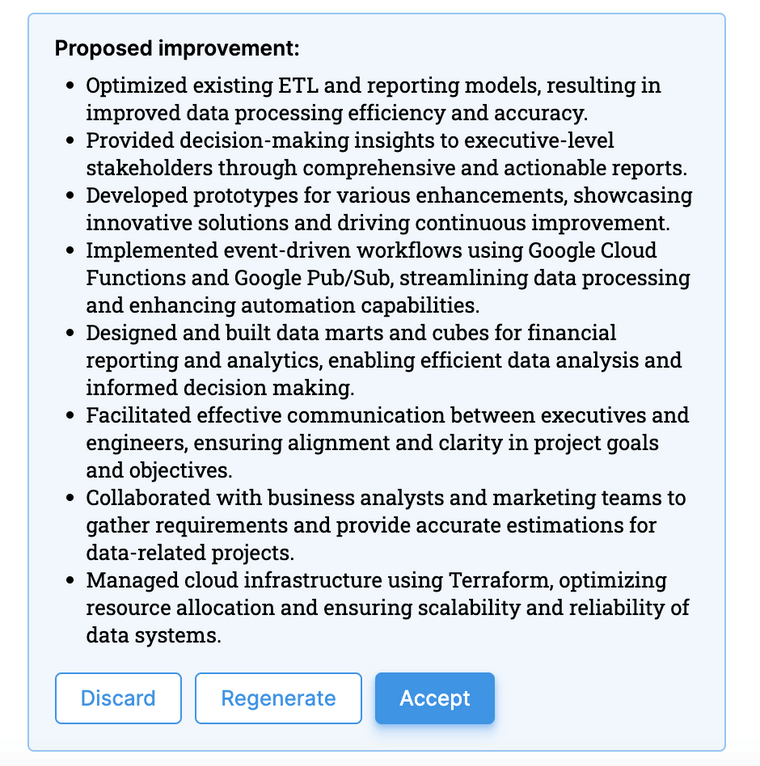
Multiple Positions, Same Company On Resume: Multiple Jobs, Promotions, Role Switch Formats and Examples

Whether you’ve been promoted, changed departments, or simply held more than one job at a single organization, it’s important to figure out how to list multiple positions at the same company on a resume.
Browse our gallery of resume examples here.
Your relationship with previous employers is an important part of your career story. Having held multiple jobs at one company shows that you can learn and grow with a workplace. This is impressive to hiring managers when you can show it effectively. If a company liked you well enough that they gave you a promotion or hired you more than once, your resume should make this clear.
Employers are always on the lookout for workers who are in it for the long haul. Finding and training new employees is expensive and time consuming, so hiring someone who doesn’t stick around long can cost the company money. When your resume shows long tenures and multiple roles at past companies, you can assure potential employers that you aren’t a job-hopper.
Browse our gallery of resume templates here.
Just how you should list multiple jobs at the same company, however, depends on your specific career journey. Your resume should tell a story and show how your career has progressed. You need to find the right formatting to leave the reader with a clear idea of how you got to where you are today.
With that in mind, here are 4 strategies for showing multiple positions at one company on your resume.
1. Stack similar job titles together
Sometimes, taking a new position doesn’t mean taking on new obligations. When the different roles you’ve held at a company are very similar, you don’t need to waste space writing the same job description twice.
If this is the case, you shouldn’t create a separate entry in your Work Experience section for each role. Instead, you can stack the job titles together and add your experience and achievements from both roles in a single entry. This single entry can then show your entire history at the company.

When to stack job titles together
Stack job titles when the jobs in question have identical or similar job descriptions. For example, you may have received a title change with no change in duties, been promoted to a job that increased your authority but didn’t change your day-to-day activities, or been transferred to a different branch office for the same role. In cases like this, describing both jobs would be repetitive.
Stacking job titles works best when you held the jobs one after the other. This way, the dates beside each role are still in order, even though they don’t have individual descriptions. If the jobs weren’t back-to-back—if you worked for a different company in between these jobs, for example—the timeline will be confusing. Only stack job titles when describing consecutive roles.
Suggested link: Cover letter examples
Further, it’s best not to stack job titles in your resume when you’re applying through an applicant tracking system (ATS). An ATS is a type of software that some employers use to read and sort resumes, and it’s important not to confuse it. When your job titles are stacked together, the ATS may have difficulty understanding which role the description applies to. If you are applying via an ATS, consider writing every job in a separate entry, even when they were at the same company.
In short, stack job titles together when:
- The jobs were consecutive
- The job descriptions were similar or the same
- You were promoted or moved for a good reason
- You aren’t submitting your resume to an ATS

How to stack multiple positions at the same company
When stacking multiple roles together, add a single heading with the company title, followed by all of the associated job titles in reverse-chronological order. Beneath that, write bullet points describing the responsibilities that apply to all roles. This allows you to efficiently show that you have held different roles without repeating yourself in different job descriptions.
To stack multiple positions at the same company together:
- At the top of the entry, write the company name
- Below that, list the relevant job titles and their dates in reverse-chronological order
- Write a job description that applies to all roles
To make sure your promotion or department change is clear, include a brief explanation in the job description. For example, the first bullet point or sentence in your job description could be:
- Promoted to Senior Manager within 2 years after successfully leading two large projects.
Or
- Transferred to a new branch office to introduce new management methodologies.
This way, any questions an employer could have about your move will be answered right away.
Template: Stacking multiple positions at the same company
Company Name Current Job | Start Date - End Date Previous Job |Start Date - End Date
- Accomplishment 1
- Accomplishment 2
- Accomplishment 3
Sample: Stacking multiple positions at the same company
Trinity Medical | 2013 - Present Vice President of Sales, 2016 - Present Regional Sales Director, 2013 - 2015
- Promoted within 2 years for superior performance.
- Increased Q1 quarter over quarter sales by 21%.
- Designed all sales compensation programs to drive sales of key products.
- Analyzed competitive intelligence to develop new go-to market approach.
- Implemented new sales strategy to recapture lost clients and grow sales of core customers.
- Reviewed sales profile and developed new sales training program.
- Managed the sales team and implemented a new culture of winning.
- Finished at #2 in the region for the year in 2014.
- Increased Year Over Year sales by $2.8M on a base of $29M in sales (2014).
2. Create separate entries for dissimilar consecutive roles
If you’ve been promoted or transferred to a role that had very different responsibilities, create separate entries for each role. Every position will need its own job description.
The entries can share the same company name heading, but the jobs themselves will need their own dedicated job description. It’s important that your resume reflects the distinct achievements and responsibilities in each position. To do this, create separate entries for each role.

When to use separate entries to list multiple back-to-back positions at the same company
If you’ve been promoted or transferred and the new job is very different from the old one, you will need to write separate job descriptions for each one. A single job description can’t cover all the duties, unlike when you stack similar entries.
When you use separate entries you can choose to list the company name only once, right above the first job. Listing the company name once will save you a line, so it is a useful way to save space on your resume. Remember that if you only list the company name once, the jobs have to be sequential. If you worked for a different company in between jobs, both roles should give the company name.
Using separate entries is better than using stacked job titles when you’re applying through an ATS. Applicant tracking systems will find it easier to read your resume when each company name and job title is right above the relevant job description.
In short, use separate entries that share a single company heading when:
- The jobs you held at the one company had different duties
- The jobs you held at the same company were consecutive
- You are applying through an ATS
How to list back-to-back positions at the same company using separate entries
When you list multiple positions at the same company on a resume using separate entries, they will look similar to the roles in other companies. The only difference is when the jobs are all back-to-back you can omit the company name from the older roles.
Use a single heading for the name of the company, with a job title and bullet points for each position below it. Arrange the roles in reverse-chronological order, and in each job description focus on the distinct accomplishments you achieved in that role. This will show that you have been successful in different contexts at the company.
To list multiple positions at the same company in separate entries:
- Give the company name once
- Below that, list the previous jobs at that organization in reverse-chronological order, including dates and descriptions
If you were promoted, be sure to draw attention to the promotion in the description of the most recent position. Promotions show that the company appreciated your work and trusted you with greater responsibilities.
Template: Separate entries multiple positions same company
Company Name Current Job Title | Start Date - End Date
- Accomplishment 1
- Accomplishment 2
- Accomplishment 3
Previous Job Title | Start Date - End Date
- Accomplishment 1
- Accomplishment 2
- Accomplishment 3
Sample: Separate entries multiple positions same company
Trinity Medical Vice President of Sales, 2016 - Present
- Increased Q1 and Q2 quarter over quarter sales by 22% and 23.5% respectively.
- Designed all sales compensation programs to drive sales of key products.
- Analyzed data and competitive intelligence to determine and execute new go-to market approach.
- Implemented new sales strategy to recapture lost clients and grow sales of core customers.
- Redefined sales profile and implemented new sales training program, positively impacting performance.
Regional Sales Director, 2013 - 2015
- Upgraded the sales team and implemented a new culture of winning.
- Finished at #2 in the region for the year in 2012.
- Increased YOY sales by $4.8M on a base of $31M in sales (2012).
- Developed 3 President Award Winners.
3. List the same company twice
No one’s career path is a straight line. Many people, especially those who work in the same industry for most or all of their career, will one day find themselves back at a company that they had left years before. If this is the case for you, your best bet is to simply list the two roles separately in your work history as though they were any other job, giving the name of the company each time.
When to list multiple jobs at the same company in separate entries non-consecutively
The only time it will be necessary to list the same company more than once non-consecutively is, appropriately, when you have held jobs with the same company more than once non-consecutively. If you work for one company, leave it for a different company, then return to the original company, you should list the jobs in the order they occurred.

How to list multiple jobs at the same company on your resume when they weren’t back-to-back
To list multiple jobs at the same company on your resume when they weren’t back-to-back, simply list them in the order they happened. Include the company title and job title in all instances. Items in your Work Experience section should be listed in reverse-chronological order, so the jobs will fit in alongside all the others.
In the most recent role, you can write a bullet point explaining why you returned to an old company. This is a good opportunity to highlight the skills or expertise that the company wants you for. If you were so good that they wanted you back, you should make a point of saying so!
Template: listing multiple jobs at the same company that aren’t back-to-back
Current Company Current Position | Start Date - End Date
- Accomplishment 1
- Accomplishment 2
- Accomplishment 3
Previous Company Previous Position | Start Date - End Date
- Accomplishment 1
- Accomplishment 2
- Accomplishment 3
Current Company Previous Position | Start Date - End Date
- Accomplishment 1
- Accomplishment 2
- Accomplishment 3
Sample: listing multiple jobs at the same company that aren’t back-to-back
Trinity Medical Vice President of Sales, 2016 - Present
- Increased Q2 quarter over quarter sales by 23.5% in 2017.
- Designed all sales compensation programs to drive sales of flagship product.
- Analyzed data and competitive intelligence to determine and execute new market approaches.
- Developed plan to recapture lost clients and grow sales to returning customers.
- Implemented new sales training program, improving performance.
Samson Pharmaceutical Products Regional Sales Director, 2013 - 2015
- Implemented a new culture of winning throughout sales team.
- Finished at #3 in the region for the year in 2014.
- Improved YOY sales by $4.8M on a base of $27M in sales (2014).
- Developed 2 President Award Winners.
Trinity Medical National Sales Director, East, 2008 - 2012
- Delivered YOY sales growth of 18% vs. organic market growth at 1% annually (2008 – 2010).
- Ranked #1 position for Region of the Year in 2009 and 2010.
- Spearheaded strategies to generate growth through MD practice development initiatives.
- Facilitated hospital marketing teams in driving patient volume to trained structural heart physicians.
4. List older jobs in a separate section
If you worked at the same company for several years, receiving promotions and working your way up the company ladder, you can show this by creating a distinct section on your resume for that company alone. The rest of your experience in other jobs will be in its own section.

When to use a separate section for multiple positions at the same company
Using a separate section for one company with many positions is best for older professionals with decades of experience, with work experience from a company that dates back several years. There should be enough roles at the former company to justify a distinct section.
This method can also be useful for people who have changed careers. Using a separate section for past jobs that aren’t as relevant to your current vocation is a good way to save space on your resume and tell your career story.
Ideally, all of your positions at a past company can be listed in reverse-chronological order. This means that you held them all in sequence, with no roles at any other company. If not, you may want to consider writing a functional resume, which can help you list past roles out of order (although most employers prefer reverse-chronological resumes).
How to use a separate section to list multiple positions at the same company.
To list all positions at one company in a distinct resume section, create two different sections for your Work History: one with all your jobs at a particular company, and one with the rest of your experience.
To do this, create a section separate from the rest of your work history. You can title the section with the name of the company, or give it a heading like “Previous Experience.” Then, within the section, list all of your job titles at that company in reverse-chronological order.
You can add descriptions to each job if necessary, but if these roles are from years ago and you have more current roles to highlight, you can leave those out. This efficiently showcases all of your previous roles and tells a clear story of how you worked your way through the company, while leaving room on your resume for more important details when you describe more recent positions.
In short, to list multiple roles at a company in a separate section:
- Create a section for your roles at one specific company
- List all your positions at that company in reverse-chronological order
- Create a different section for other work experience
- List your other positions in this section
Template: Listing multiple positions at the same company in a separate section
Prior Professional Experience Company Name Job Title | Start Date - End Date Job Title | Start Date - End Date Job Title | Start Date - End Date
Sample: Displaying multiple positions at the same company in a separate section
Trinity Medical Vice President of Sales, 2003 - 2005 National Sales Manager, 2000 - 2002 Regional Sales Director Southwest, 1997 - 2000
Sample resume: multiple positions, same company
The way you format your resume depends on the way your career journey unfolds. Were you promoted to a new position? Headhunted by a previous company to come back for a management role? Did you work your way up the company ladder? Were you moved to a struggling branch because of your success at a previous branch? Whichever it is, make sure you list your multiple positions at the same company in a way that shows you to be the great employee you are.
If you need some inspiration to get started, this sample resume could help:
Public relations officer resume sample
SUMMARY
Enthusiastic public relations officer who has a passion for working in a fast-paced environment. Highly skilled in persuasive communication and relationship management. Strong understanding of organizational boundaries. My previous experience in public relations includes analysis, team coordination, planning, and operational and administrative functions. Skilled team builder with demonstrated success in improving the image of institutions.
WORK EXPERIENCE
OGILVY & MCCANN Senior Public Relations Officer, 2020 - PRESENT
- Plan publicity strategies and campaigns, including PR outreach, social media campaigns, and articles.
- Train and manage interns.
- Supervise social media output.
- Represent clients at industry events.
- Write and produce presentations and press releases.
- Create, curate, and manage published content.
- Create reports for management showing ROI.
Public Relations Officer, 2015 - 2019
- Planning publicity strategies and campaigns.
- PR campaigns/social media campaigns/writing articles and designing visual graphics.
- Managing and training interns.
- Manage social media account.
- Compile reports for management showing results.
- Create strategic messaging on social media to grow our community.
- Working together with the Independent media group social media and audience development delegate to draw up and implement strategies to tap into potential markets and possible sale opportunities.
- Designing social media strategies to achieve marketing targets.
- Managing, creating and publishing original, high quality content on social platforms.
- Administering all company social media accounts to ensure up-to-date content.
Content Marketing Specialist, 2011 - 2015
- Created and curated engaging content.
- Communicated and build relationships with current or prospect clients.
- Created and distributed press releases.
- Built and updated media lists and databases.
- Scheduled, coordinated and attended various events.
- Performed research and market analysis activities.
- Written and produced presentations and press releases.
- Tracked social media performance and content coverage for clients.
POWERTRAIN Industries, 2009 - 2011 Public Relations intern
- Processed of all types of applications and paperwork.
- Assisted in office administrative duties.
- Performed research and market analysis.
- Tracked social media performance and content coverage .
EDUCATION
YALE UNIVERSITY BA in Economics
SKILLS
- CREATIVITY
- COMMUNICATION
- DIGITAL STRATEGIST
- PROBLEM-SOLVING SKILLS

Should you list multiple positions on your resume for the same company?
Displaying multiple positions on your resume for the same company shows a hiring manager that you are reliable and in it for the long haul. It adds weight to your job application and helps your resume stand out.
How do you put multiple positions at the same company on a resume?
Here are 4 ways to list multiple positions at the same company on your resume:
- Stack similar job titles together
- Create separate entries for dissimilar consecutive roles
- List the same company twice
- List older jobs in a separate section
- 1. Stack similar job titles together
- 2. Create separate entries for dissimilar consecutive roles
- 3. List the same company twice
- 4. List older jobs in a separate section
- Sample resume: multiple positions, same company
- Should you list multiple positions on your resume for the same company?
- How do you put multiple positions at the same company on a resume?

Written By
Ben Temple
Community Success Manager & CV Writing Expert
Ben is a writer, customer success manager and CV writing expert with over 5 years of experience helping job-seekers create their best careers. He believes in the importance of a great resume summary and the power of coffee.

Read our free guide to the best action words to use on your resume.
November 23, 2021
Read Post

Co-Founder & Director
![The 2025 Resume Writing Guide [+ Job Search Tips and Resume Examples]](/static/0a451b7c20b67c3a0ce6a7b4a7680f5f/61ca5/Resume_Guide.jpg)
The 2025 Resume Writing Guide is filled with quality job search tips, resume examples and information you need to know before writing your resume or CV.
January 3, 2025
Read Post

VP Marketing & Resume Expert

Learn how your resume can beat the applicant tracking system (ATS) with keywords and the right resume template.
February 7, 2022
Read Post

Community Success Manager & CV Writing Expert
Copyright ©2025 Workstory Inc.